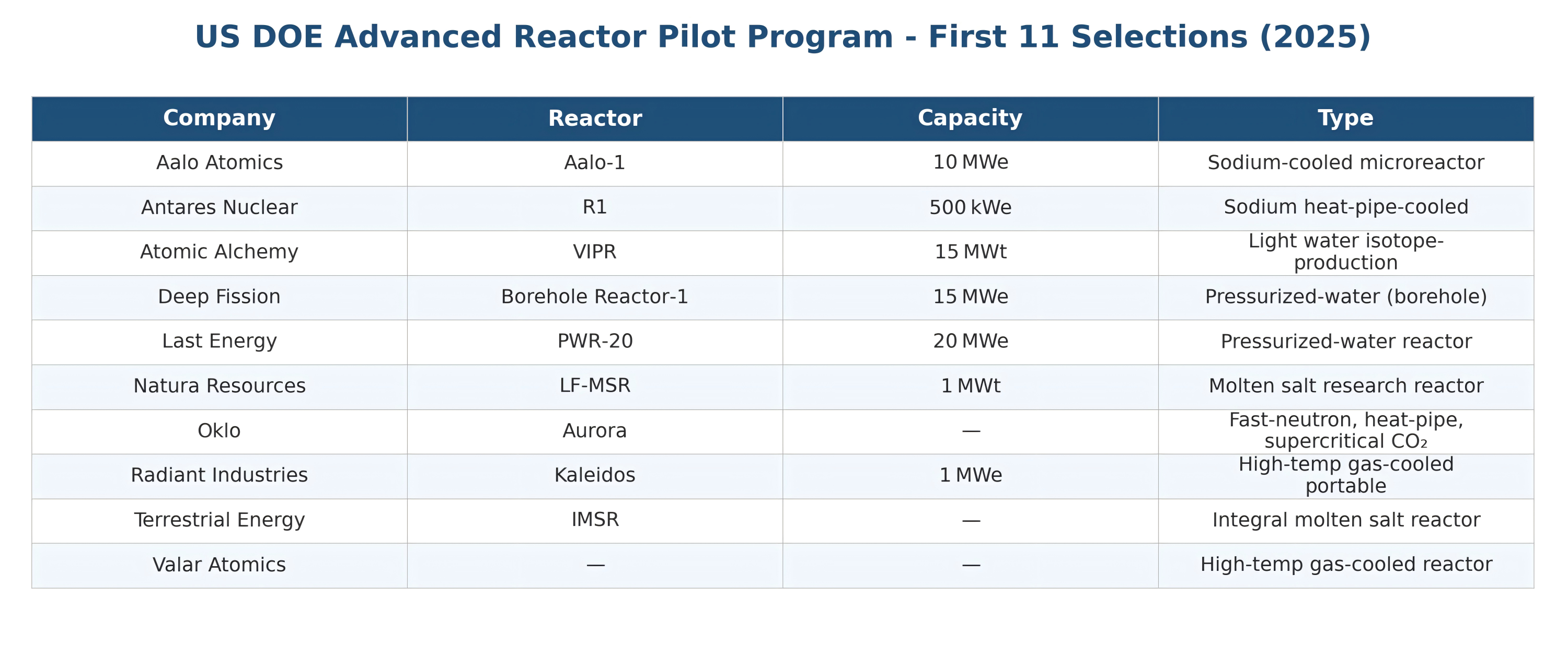The U.S. Department of Energy (DOE) has announced the initial selection of 11 advanced reactor projects under its Nuclear Reactor Pilot Program, with the objective of seeing at least three of these projects reach criticality within the next year.

Launched in June following Executive Order 14301 signed by President Trump in May, the pilot program enables DOE to authorize testing of advanced reactor designs at sites outside national laboratories. By leveraging DOE authorization rather than the traditional Nuclear Regulatory Commission (NRC) licensing process, the program aims to significantly accelerate the deployment of new reactor technologies.
The 11 selected entities and their reactor types include:
Aalo Atomics Inc. — Aalo-1: factory-fabricated 10 MWe sodium-cooled microreactor
Antares Nuclear Inc. — R1: 500 kW sodium heat-pipe-cooled reactor
Atomic Alchemy Inc. (Oklo subsidiary) — VIPR 15 MWt light water isotope-production reactor
Deep Fission Inc. — Deep Fission Borehole Reactor-1: 15 MWe pressurized-water reactor in subsurface borehole
Last Energy Inc. — PWR-20: 20 MWe pressurized-water reactor
Natura Resources LLC — LF-MSR: 1 MWt molten salt research reactor
Oklo Inc. — Aurora: fast-neutron reactor with heat pipes and supercritical CO₂ power conversion
Radiant Industries Inc. — Kaleidos: 1 MWe high-temperature gas-cooled portable microreactor
Terrestrial Energy Inc. — IMSR: Integral Molten Salt Reactor
Valar Atomics Inc. — High-temperature gas-cooled reactor design.
According to Reuters and Barron’s, the pilot program is being driven by soaring electricity demands from AI and data centers. DOE positions small modular and advanced reactors as potentially cheaper and faster-to-deploy alternatives to large conventional reactors, emphasizing fast-tracked licensing and market deployment without traditional NRC involvement.
DOE Deputy Secretary James Danly remarked, “President Trump’s Reactor Pilot Program is a call to action … We will do everything we can to support their efforts to safely achieve criticality by Independence Day.”
Inside Climate News highlights concerns from experts about bypassing the NRC, raising questions about transparency and public accountability. “The Department of Energy is a self-regulated body with no transparency or real public input,” noted Edwin Lyman, a nuclear safety director with the Union of Concerned Scientists.
Still, some industry leaders view the program as a potential catalyst for the commercialization of SMRs and advanced reactors. Simon Irish, CEO of Terrestrial Energy, said the DOE’s support would help the U.S. “win the race to energy dominance…in the AI and manufacturing sectors.”
DOE’s first-round selection of 11 advanced reactor projects, featuring diverse technologies from sodium-cooled microreactors to molten salt and gas-cooled designs, underscores an ambitious plan to realize at least three test reactors within the next year. While the pilot offers a new regulatory pathway and commercial momentum, ensuring safety and transparency remains a key challenge.